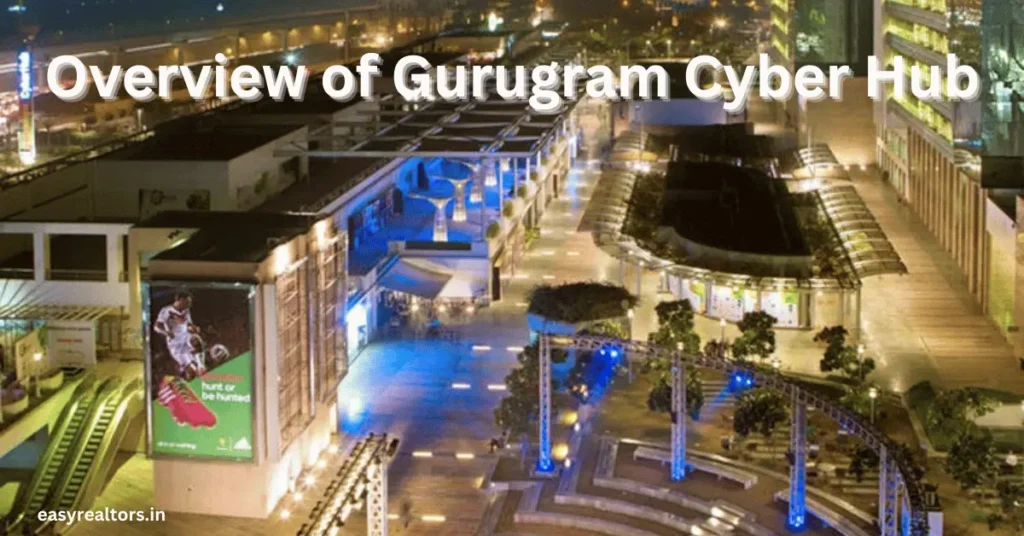Overview of Gurugram Cyber Hub: A Timeline of Growth and Development

Overview
Early Development (Early 2000s):
Gurugram’s transformation into a commercial and IT hub began in the early 2000s. The city’s strategic location near Delhi, improved infrastructure, and favorable business environment attracted major multinational companies and IT firms. This led to a surge in commercial real estate development, laying the foundation for Cyber Hub’s future growth.
Launch and Concept (2010-2014):
Cyber Hub was launched in 2013 as part of DLF Cyber City, a prominent corporate park in Gurugram. It was conceived as a premium social and entertainment destination, integrating office spaces with restaurants, pubs, cafes, and entertainment zones. This unique concept set Gurugram Cyber Hub apart, offering a holistic experience for professionals and residents alike.
Expansion and Popularity (2015-2018): Gurugram Cyber Hub
The period between 2015 and 2018 witnessed rapid expansion and growing popularity of Gurugram Cyber Hub. More restaurants, bars, and cafes opened up, catering to the increasing demand from visitors. The hub became a cultural hotspot, hosting music events, food festivals, and art exhibitions, attracting a diverse crowd from across the National Capital Region (NCR).
Impact on Economy and Lifestyle:
Cyber Hub’s growth has had a significant impact on Gurugram’s economy and lifestyle. It has created job opportunities, boosted the hospitality and retail sectors, and contributed to the city’s overall economic growth. Additionally, Cyber Hub has enriched Gurugram’s cultural scene, offering residents and visitors a vibrant social and entertainment experience.
Future Prospects and Challenges:
Looking ahead, Gurugram Cyber Hub’s future prospects are promising. The hub is expected to continue evolving, incorporating advanced technologies and sustainable practices to enhance visitor experience and operational efficiency. However, challenges such as maintaining a balance between commercialization and preserving the area’s cultural and architectural heritage need to be addressed.
Also read: Gurgaon Real Estate Market Forecast 2024: Trends, Insights, and Opportunities
Government’s Choice of Gurugram as IT Sector Hub: Gurugram Cyber Hub
Proximity to Delhi:
Gurugram’s proximity to Delhi makes it an attractive location for businesses, offering easy access to government offices, international embassies, and key institutions. The city’s strategic location has helped in attracting major corporations and IT firms, contributing to its growth as an IT hub.
Infrastructure Development:
Significant infrastructure development in Gurugram has created a conducive environment for the IT sector to thrive. The city has witnessed the development of world-class commercial spaces, residential complexes, and modern amenities, making it an ideal destination for IT companies to set up operations.
Presence of Major Corporations:
Gurugram is home to several major corporations, including multinational IT companies, creating a conducive ecosystem for the growth of the IT sector. The presence of these corporations has not only attracted more companies to the region but also boosted the local economy and job market.
Skilled Workforce:
Gurugram boasts a skilled workforce in IT and related fields, making it easier for companies to recruit and expand their operations. The availability of a talented pool of professionals has been a key factor in attracting IT companies to the region, further solidifying Gurugram’s position as an IT hub.
Government Support:
The government of Haryana has provided various incentives and support measures to encourage IT companies to set up operations in Gurugram. These include tax benefits, subsidies, and streamlined regulatory processes, making it easier for companies to establish and grow their businesses in the city.
Decoding Circle Rates in Gurugram
Impact of Gurugram IT Hub on Real Estate:
Increase in Commercial Real Estate Demand:
The establishment of IT companies has led to a surge in demand for commercial office spaces, resulting in the development of modern office complexes and business parks. Areas around IT hubs have seen significant growth in commercial real estate development, with new office spaces catering to the growing demand.
Rise in Residential Demand:
The influx of IT professionals has boosted the demand for residential properties, leading to the development of apartments, gated communities, and townships. Residential projects near IT hubs are particularly in demand, offering convenient living options for employees working in the IT sector.
Infrastructure Development:
Supporting infrastructure such as roads, highways, metro lines, and public transportation systems has enhanced connectivity and accessibility. The development of infrastructure has not only benefited the IT sector but also improved the overall livability of Gurugram and its nearby regions.
Upsurge in Property Prices:
Increasing demand has led to a steady rise in property prices, particularly in areas close to IT hubs. Properties near IT hubs are often priced higher due to their proximity to workplaces and amenities, making them attractive for both investors and homebuyers.
Emergence of Satellite Towns:
The growth of Gurugram’s IT sector has extended to nearby towns, leading to increased real estate development in satellite towns like Sohna, Manesar, and Dharuhera. These towns offer affordable housing options for IT professionals and their families, further driving the growth of the real estate sector in the region.
Unlocking Rental Yields in Gurugram
Factors to Consider When Buying Real Estate in Gurugram:
Location and Connectivity:
Gurugram’s location and connectivity to key areas such as Delhi, major highways, and the international airport are crucial considerations. Proximity to workplaces, schools, hospitals, and other essential amenities should also be taken into account.
Infrastructure Development:
The city’s infrastructure, including roads, public transportation, and upcoming projects like metro lines, can impact property values and livability. Areas with planned infrastructure development may offer better growth prospects.
Property Type and Developer Reputation:
Choose a property type that suits your needs and ensure the developer has a track record of delivering quality projects on time. The reputation of the developer is critical in ensuring a hassle-free buying experience and future appreciation of the property.
Amenities and Facilities:
Consider the amenities offered in the property, such as parking, security, power backup, and recreational facilities. These amenities can enhance your living experience and add value to the property. Properties with well-maintained amenities often have higher resale value and rental potential.
Market Trends and Resale Value:
Analyze market trends, demand-supply dynamics, and potential for future appreciation. Consider the property’s resale value and rental potential. A property in a high-demand area with limited supply is likely to have better resale value and rental income potential.
In conclusion, the development of Gurugram as an IT hub has had a transformative impact on the real estate sector, driving growth and development in Gurugram and its surrounding regions. The city’s strategic location, coupled with government support and infrastructure development, has made it an attractive destination for both IT companies and real estate investors.
Gurgaon Real Estate Investment Insights
for more updates follow us on instagram


